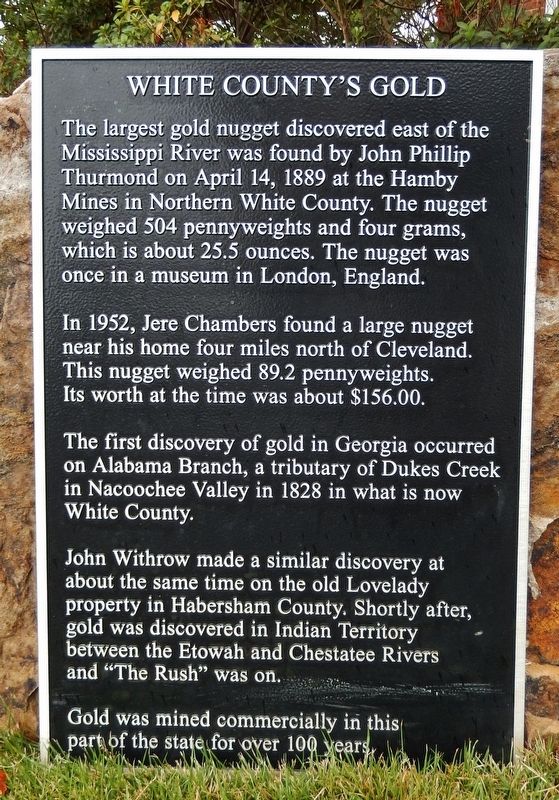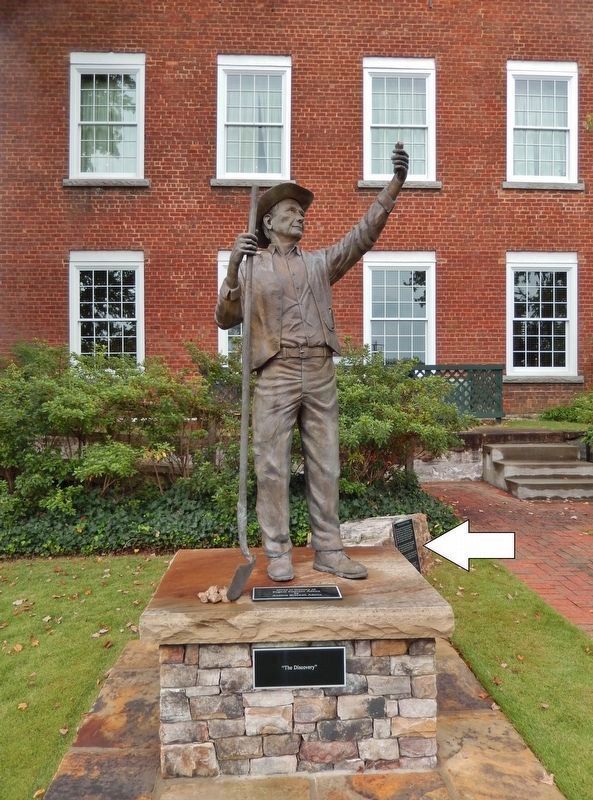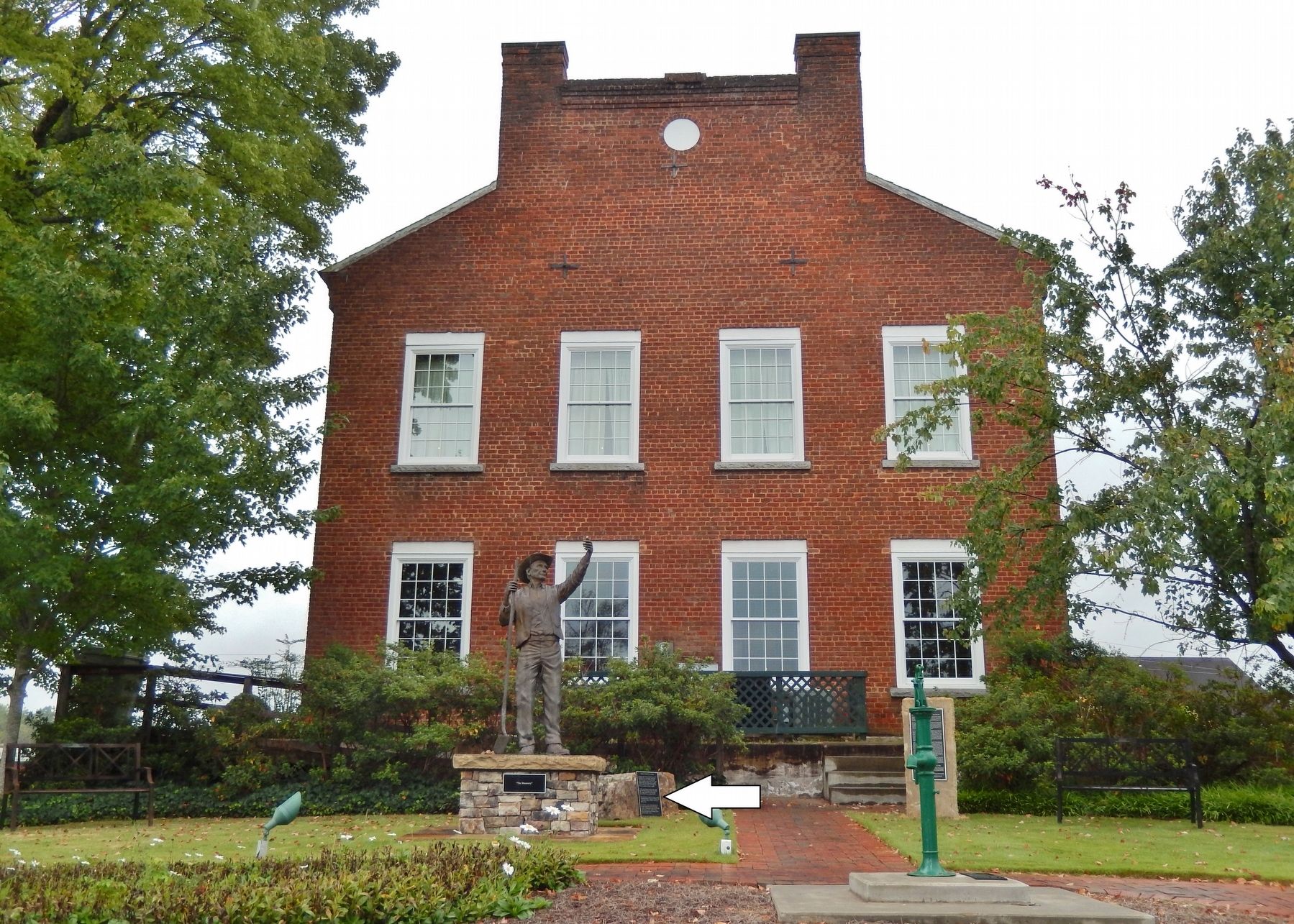Cleveland in White County, Georgia — The American South (South Atlantic)
White County's Gold
In 1952, Jere Chambers found a large nugget near his home four miles north of Cleveland. This nugget weighed 89.2 pennyweights. Its worth at the time was about $156.00.
The first discovery of gold in Georgia occurred on Alabama Branch, a tributary of Dukes Creek in Nacoochee Valley in 1828 in what is now White County.
John Withrow made a similar discovery at about the same time on the old Lovelady property in Habersham County. Shortly after, gold was discovered in Indian Territory between the Etowah and Chestatee Rivers and "The Rush" was on.
Gold was mined commercially in this part of the state for over 100 years.
Topics. This historical marker is listed in this topic list: Natural Resources. A significant historical date for this entry is April 14, 1889.
Location. 34° 35.831′ N, 83° 45.795′ W. Marker is in Cleveland, Georgia, in White County. Marker can be reached from the intersection of Courthouse Square (North Main Street) (U.S. 129) and East Jarrard Street, on the left when traveling south. Marker is located on the Old White County Courthouse Museum grounds, beside the walkway on the north side of the building. Marker is mounted vertically, at ground-level, on a large stone. Touch for map. Marker is at or near this postal address: 20 Courthouse Square, Cleveland GA 30528, United States of America. Touch for directions.
Other nearby markers. At least 8 other markers are within 7 miles of this marker, measured as the crow flies. Mustering Grounds (here, next to this marker); Old White County Courthouse (a few steps from this marker); White County (within shouting distance of this marker); Cleveland (within shouting distance of this marker); Mossy Creek and Rock Springs Campgrounds (approx. 5.6 miles away); Discovery of Gold (approx. 5.8 miles away); Nacoochee Indian Mound (approx. 6.8 miles away); Nacoochee Mound (approx. 6.8 miles away). Touch for a list and map of all markers in Cleveland.
Also see . . .
1. Gold Rush. New Georgia Encyclopedia entry:
There are several popular stories of the beginning of Georgia’s gold rush; but in fact, no one is really certain who made the first discovery or when. (Submitted on May 18, 2022, by Larry Gertner of New York, New York.)
2. White County marks 'discovery' of gold with bronze statue. Cleveland Times website entry:
Gold was first discovered Georgia in 1828 in the White County by a slave in a tributary of Dukes Creek in Nacoochee Valley of what is now White County. Gold was also discovered in the nearby city of Dahlonega in Lumpkin County the same year. These discoveries sparked the first U.S. gold rush. (Submitted on April 1, 2019, by Cosmos Mariner of Cape Canaveral, Florida.)
3. Georgia Gold Rush. Wikipedia entry:
The Georgia gold rush started in 1829 in Lumpkin County and began spreading rapidly. The Macon Telegraph reported that in "the winter of 1829 and 30, when the precious metals having been discovered in great abundance upon our Cherokee soil, great numbers of people from Georgia and other States rushed to the Territory in search of its treasures." By the 1840s gold mining in Georgia saw a sharp decline, as the gold began to "play out". (Submitted on April 1, 2019, by Cosmos Mariner of Cape Canaveral, Florida.)
Credits. This page was last revised on May 18, 2022. It was originally submitted on March 31, 2019, by Cosmos Mariner of Cape Canaveral, Florida. This page has been viewed 2,047 times since then and 357 times this year. Photos: 1. submitted on March 31, 2019, by Cosmos Mariner of Cape Canaveral, Florida. 2, 3. submitted on April 1, 2019, by Cosmos Mariner of Cape Canaveral, Florida.


